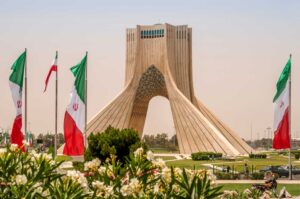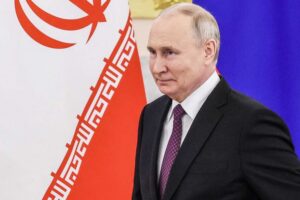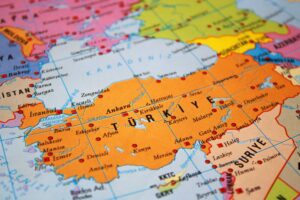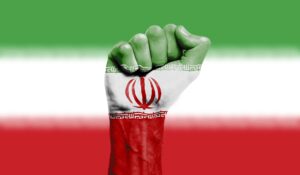In his book, The Centre of the Universe, Graham Fuller, a former CIA officer, says that the presence of foreign countries in the Persian Gulf has prevented the formation of a “natural order” in the region.[i] According to Fuller, natural order in the Persian Gulf is achieved when the countries of the region either rely on their military capability to balance against each other or ally with other countries in the region rather than with non-regional countries. In such a case, regional diplomacy will be more greatly emphasized by the countries of the Persian Gulf.
The long-term presence of the United States in the Persian Gulf and the attendant establishment of hegemonic order in the region over the years has led to the formation of relations between Arab countries, including the United Arab Emirates, with Iran.
But now, with the US gradually moving away from hegemony in the Gulf and focusing on China in the Indo-Pacific, emphasizing its “offshore balancing” strategy,[ii] we are witnessing new developments, the most important of which is that countries in the region are turning to diplomacy to keep up with regional rivals on the one hand, and to form alliances in order to strike a balance against competitors on the other. In other words, while a positive policy is pursued through diplomacy, a negative policy is followed in the form of new alliances and coalitions.
The Effects of the US’ Withdrawal from the Persian Gulf
With the decline of US strategic inclination to regulate order in the Persian Gulf, such a function has been weakened and, at the same time, no rival power has replaced it.
The importance of this issue is that the behavior of the countries of the Persian Gulf region has been mainly influenced by international politics. In other words, in the macro perspective, there is a significant relationship between structural changes in the international system and the dynamics of alliances in the changing geopolitics of the Persian Gulf. Historically, after the Cold War, the conditions of the unipolar system and the undisputed power of the United States shaped the alliance building approaches of its allies and enemies. In recent years, with the decline of US hegemony or, at least, a reduction in its strategic inclination to regulate order in the Persian Gulf, such a function has been weakened and, at the same time, no rival power has replaced it.
Under the “offshore balancing” strategy, the vital interests of the United States are defined in terms of security, economic prosperity, and its core values – and those of its key allies in Europe, parts of Asia, the Middle East, and the Persian Gulf. Accordingly, the United States will keep a large part of its military forces out of conflicts, and intervention will only take place as a last resort when there is no other way to protect vital interests. Thus, the United States must delegate its responsibility to other nations in order to succeed in its role as an offshore balancer. In other words, it should try to remove itself from direct conflict in the region and instead control the situation from offshore.[iii] For example, when Yemeni Houthis attacked Saudi Aramco, King Salman asked then-President Donald Trump to attack Iran in support of Saudi Arabia. Trump told him that if King Salman took personal responsibility for the attack on Iran, Washington would do it. By contrast, following Saddam Hussein’s attack on Kuwait, the United States did not wait for a UN Security Council resolution and attacked Saddam Hussein’s forces.
Moreover, the US’ regional interests have changed. The US Global Posture Review (GPR)[iv] document emphasizes the reduction of US military presence in the Middle East in favour of an increase of its military presence in the Indo-Pacific. At the same time, it is highly unlikely that China will take the place of the United States in the Persian Gulf and the Middle East. China’s strategy is economy- rather than security-based.
Entry of Regional Powers
In such a context, regional powers have found a special position in shaping the changing order of the Persian Gulf region. Limitations in structural power and a lack of capacity to exercise hegemonic order by any of the regional actors has led them to recruit and form regional alliances to expand influence and shape the path of the Persian Gulf interactions. In the post-2011 Arab Spring period, while traditional centers of power in the Arab Middle East such as Egypt, Syria and Iraq have become the focus of regional conflicts, regional politics have, in many cases, been influenced by non-Arab powers such as Iran, Turkey, and Israel in addition to one Arab power, Saudi Arabia. Moreover, while Saudi Arabia and Israel have sought to maintain the status quo, Iran and Turkey, perceiving their national role as anti-hegemonic powers, have mobilized their sources of power to undermine the hierarchy and order of the region.
As the United States withdraws its troops, countries in the region are forced to resort to diplomacy. We have witnessed a significant increase in diplomatic activity among regional actors since the election of Joe Biden as President of the United States. Importantly, such diplomatic activities occur at the initiative of governments of the region. For example, Arab governments of the Persian Gulf were disappointed by the inclusion of the issue of regional policy under the JCPOA, and hence, regional negotiations began before the start of the Vienna talks. Current negotiations are primarily focused on the nuclear issue despite efforts made by the United States, France, Germany and England to include Iran’s regional policy and questions regarding missile capabilities under their umbrella.
A Recalibration: The UAE Forges Closer Ties with Iran and Syria
Countries such as the UAE have sought to improve relations with Iran. This is a notable shift in the Emirates’ foreign policies towards its neighbor, which seems to be driven by adopting a more pragmatic approach for the sake of security and economic benefits.[v]
The UAE did not sever ties with Iran even at the height of political tensions, indicating a balanced approach. Following the 2016 attack on the Saudi embassy in Tehran, the UAE joined its Gulf Cooperation Council partners and condemned Iran, but refused to close its embassy in Tehran. Indeed, even during the rule of the former Shah of Iran, Mohammad Reza Pahlavi, the UAE found ways to put aside its differences and cooperate with Tehran. In 1971, following disputes over the Tonbs and Abu Musa islands, the UAE’s leadership was outraged by Iran’s control over the islands, but it never allowed the dispute to jeopardize Abu Dhabi’s trade and diplomatic relations with Tehran.[vi] In line with Abu Dhabi’s balanced foreign policy strategy, the UAE, unlike many GCC countries, has never severed ties with Syria. It is also the first country in the Persian Gulf to talk about the need for Syria to return to the Arab League.
The UAE did not sever ties with Iran even at the height of political tensions, indicating a balanced approach.
Abu Dhabi knows that the way to improve relations with Syria leads through Iran. In an effort to improve relations with Syria and Iran, Tahnoun bin Zayed Al Nahyan, the UAE’s national security adviser, visited Iran and met with their security and government officials. His visit coincided with the visit of Faisal Mekdad, the Syrian Foreign Minister to Iran, which indicates the UAE’s strong willingness to find indirect means by which it can improve its relations with Damascus.[vii]
Saudi Crown Prince Mohammed bin Salman conducted a diplomatic trip at the same time with the notable difference of visiting Oman first, highlighting a difference in the priorities of Saudi Arabia. As the Saudi alliance with the UAE, its main partner in the war in Yemen, has waned, the Sultanate of Oman has now become a higher priority for Riyadh. The visit of the Sultan of Oman, Haitham bin Tariq, to Saudi Arabia, which was the first visit of a Sultan of Oman to Saudi Arabia in a decade, and the signing of trade agreements are significant in this regard.[viii]
Mohammed bin Salman conducted a diplomatic trip at the same time with the notable difference of visiting Oman first, highlighting a difference in the priorities of Saudi Arabia.
It should be noted that the UAE’s interventions in the conflicts in Yemen and Libya has caused financial, diplomatic and reputational damage to the country. This damage has been compounded by the Covid-19 pandemic, which has hit the UAE’s economy hard. Improving relations with Iran and Syria can help the country economically. In addition to the fact that Iran imports most of its goods through the UAE, economic cooperation between the two countries in the field of international corridors can also be beneficial for both countries.[ix] According to official Iranian figures, the value of trade between the two countries hit nearly $1.5 billion in the first five months of the current Iranian calendar year (March 2021-August 2022). The UAE is also Iran’s fourth largest export market for non-oil trade with an estimated value of $2.9 billion in goods.[x]
A Caveat in New Relations? The UAE’s Continued Links to the US, Israel, and Saudi Arabia
It should be noted that the UAE’s economic and trade relations with Iran are also associated with the sensitivities of the United States and Israel. Despite the UAE-Iran-Turkey tripartite agreement to set up a land corridor between the three countries, the UAE seems to have given up under US pressure and wants to establish land connection to Turkey via Iraq instead.[xi] One of the reasons for this is the economic rivalry between the UAE and Saudi Arabia as the end of the oil era in the Persian Gulf approaches. The differences in OPEC Plus and Riyadh’s recent decisions regarding the non-oil economy indicate an intensification of competition between the two countries in the future.
Saudi officials have announced the end of preferential tariffs for Persian Gulf states that buy goods in the free zones. The UAE is one of the major import partners of the Kingdom of Saudi Arabia. These areas which have significant tax benefits are abundant throughout the UAE. Israeli goods are also affected by the Saudi move. One of the main elements of the UAE’s agreement with Israel concerns trade.
Additionally, Saudi officials announced that all companies that are not headquartered in Saudi Arabia will no longer be able to work with the kingdom from 2024. This ultimatum is another blow to its ally in the Persian Gulf. Twenty-four major international companies have announced their intention to move their regional headquarters to the Saudi capital. This trend could be much more intense as Saudi Arabia seeks to attract a maximum of 500 multinational companies to its territory over ten years. Dubai hosts 140 regional centers, a record in the region.[xii] Moreover, the construction of the city of Neom by Saudi Arabia and Crown Prince Mohammed bin Salman’s Vision 2030 economic and social reform plans may also intensify the rivalry between Saudi Arabia and the UAE in the region, potentially moving competition beyond the economic sphere and into the political arena.
The UAE's new policy entails building bridges of communication, expanding diplomatic and mediation efforts, and avoiding all confrontations.
Tahnoun’s visit to Iran is but an additional sign that the UAE has decided to launch the third decade of this millennium by adopting a “zero problem” policy towards its regional rivals and adversaries: Iran, Turkey, and Qatar. The new policy entails building bridges of communication, expanding diplomatic and mediation efforts, and avoiding all confrontations that may deter Abu Dhabi’s endeavor to boost the country’s national economy in the post Covid era.[xiii]
The issue of security has become more important than ever for the UAE and Saudi Arabia. Biden’s withdrawal from Afghanistan and the withdrawal of US combat troops from Iraq since January 1, 2022, have raised concerns in the two countries. Even during Trump’s presidency and Mohammed bin Zayed’s special relationship with White House officials, the United States did not take effective action after an attack on tankers in Al-Fujairah. Accordingly, a UAE Coast Guard delegation visited Tehran to improve maritime cooperation in the waters separating the two countries. The UAE resumed security talks with Iran, which had been inactive for several years.[xiv]
Despite the UAE joining Saudi Arabia to intervene in Yemen, Abu Dhabi has so far shown little interest in fighting the Houthis, Iran’s allies in Sanaa which dominate northern Yemen. Instead, the UAE has concentrated its efforts in southern Yemen and formed a strong alliance with the Southern Transitional Council. Eventually, the UAE withdrew from the Saudi-led coalition, but expanded its influence in the south, supporting the anti-Abdrabbuh Mansur Hadi separatists in southern Yemen. Such actions understadably raised suspicions in Riyadh.
The UAE, on the other hand, wants to reassure Iran that its relations with Israel are not against Iran. Despite the dramatic acceleration of rapprochement between the UAE and Israel, the UAE government says its relations with the Jewish state are of a commercial and cultural nature. For this reason, Israel’s prime minister, Naftali Bennett did not have a private meeting with UAE ministers, and defense and security officials, including Sheikh Tahnoon bin Zayed upon his visit to the country.[xv]
Although Iran might seem to be reluctant in adjusting to UAE-Israel normalization , Tehran is perfectly aware that the accord does not entail a zero-sum policy for either Iran or the UAE. Iranian policy makers realize that UAE-Israel normalization need not be viewed as counterproductive to Tehran’s relations with the UAE, just as the Iranian dialogue with the UAE does not affect the strategic gains Abu Dhabi stands to reap because of its normalization with Tel Aviv.[xvi]
UAE-Israel normalization need not be viewed as counterproductive to Tehran’s relations with the UAE, just as the Iranian dialogue with the UAE does not affect the strategic gains Abu Dhabi stands to reap because of its normalization with Tel Aviv.
If Iran’s nuclear talks succeed, the UAE plans to expand trade relations with Iran as a result of the lifting of sanctions. As much of Dubai’s wealth comes from operating as a commercial and financial hub in the region, the UAE is hoping to reopen legal trade with Iran. Conversely, the failure of the Vienna talks would hurt the UAE’s economy too.
As the UAE does not want to be the target of asymmetric attacks by Iran, regardless of the outcome of the JCPOA negotiations, Sheikh Tahnoon’s visit to Iran reflects the UAE’s normal practice of keeping its lines of communication open with all important players in the Gulf.
Conclusion
Relations between Iran and the UAE are improving and expanding on the basis of mutual security and economic needs, and are likely to continue to do so regardless of the outcome of the nuclear talks.
This improvement of ties is the result of a new US “offshore balancing” strategy in the region, which has spurred regional countries towards pursuing their own diplomatic initiatives. The UAE is motivated to develop regional diplomatic relations due to two main aspects. From a regional perspective, the UAE’s policies after the Arab Spring and its intervention in countries such as Syria, Yemen and Libya have cost the country dearly. From a domestic perspective, the UAE has considerable – and growing – economic needs, which are particularly demonstrated by its competition with Saudi Arabia over the gradual transition to a post-oil economy. This has meant that the UAE is making efforts to reduce tensions with regional actors, such as Iran, Turkey, and Qatar, contrary to previous years’ policies. This benefits countries such as Iran as well: by improving relations with the UAE, Iran can find a way out of difficult economic conditions and use the UAE’s potential to improve trade relations and the overall well-being of the country.
[i] Graham E. Fuller, The Center of Universe: The Geopolitics of Iran, Boulder, Colo.: Westview Press, 1991.
[ii] John J. Mearsheimer and Stephen M. Walt, “The Case for Offshore Balancing, A Superior U.S. Grand Strategy,” Foreign Affairs, July/August 2016, available at: https://www.foreignaffairs.com/articles/united-states/2016-06-13/case-offshore-balancing.
[iii] Javad Heiran-Nia, “How Iran sees the Biden doctrine for the JCPOA and Persian Gulf,” Atlantic Council, November 24, 2021, available at: https://www.atlanticcouncil.org/blogs/iransource/how-iran-sees-the-biden-doctrine-for-the-jcpoa-and-persian-gulf/.
[iv] “DoD Concludes 2021 Global Posture Review,” U.S. Department of Defense, Nov. 29, 2021, available at: https://www.defense.gov/News/Releases/Release/Article/2855801/dod-concludes-2021-global-posture-review/
[v] Mohammad Barhouma, “The Reshaping of UAE Foreign Policy and Geopolitical Strategy,” Carnegie Endowment for International Peace, January 04, 2022, available at: https://carnegieendowment.org/sada/86130.
[vi] “What is the UAE’s Endgame with Iran?” December 15, 2021, available at: https://gulfif.org/what-is-the-uaes-endgame-with-iran/.
[vii] “Reasons for the simultaneous visit of Emirati and Syrian officials to Iran from the perspective of regional analysts,” Tasnim News Agency, December 7, 2021, available at: https://www.tasnimnews.com/fa/news/1400/09/16/2621486.
[viii] “Oman’s Sultan visits Saudi Arabia on first overseas trip,” Al Jazeera Media Network, 11 Jul 2021, available at: https://www.aljazeera.com/news/2021/7/11/omans-sultan-visits-saudi-arabia-on-first-overseas-trip.
[ix] “3 reasons for the Emirati official to change his policies towards Iran,” Hamshahri Online, December 9, 2021, available at: https://www.hamshahrionline.ir/news/642142.
[x] “Trade between Iran and the UAE reached more than $ 1 billion in five months,” Tasnim News Agency, September 04, 2021, available at: https://www.tasnimnews.com/fa/news/1400/06/13/2565751.
[xi] “UAE change of mind about transit of goods from Iran, Who is behind the scenes?” Mehr News Agency, January 2, 2022, available at: https://www.mehrnews.com/news/5389267.
[xii] Nicolas Keraudren, “Entre l’Arabie saoudite et les Emirats, une rivalité grandissante,” Les Echos, September 28, 2021, available at: https://www.lesechos.fr/monde/afrique-moyen-orient/entre-larabie-saoudite-et-les-emirats-une-rivalite-grandissante-1349893.
[xiii] Mohammad Barhouma, “The Reshaping of UAE Foreign Policy and Geopolitical Strategy,” Carnegie Endowment for International Peace, January 04, 2022, available at: https://carnegieendowment.org/sada/86130.
[xiv] Javad Heiran-Nia, “Reasons for the recent dialogue between Iran and the UAE, Abu Dhabi and the ‘Hormuz Peace Endeavor’,” Mehr News Agency, August 4, 2020, available at: https://www.mehrnews.com/news/4990105.
[xv] Hussain Abdul-Hussain, “UAE balances Israel ties with Iran detente,” Asia Times, December 20, 2021, available at: https://asiatimes.com/2021/12/uae-balances-israel-ties-with-iran-detente/.
[xvi] Mohammad Barhouma, “The Reshaping of UAE Foreign Policy and Geopolitical Strategy,” Carnegie Endowment for International Peace, January 04, 2022, available at: https://carnegieendowment.org/sada/86130.
















